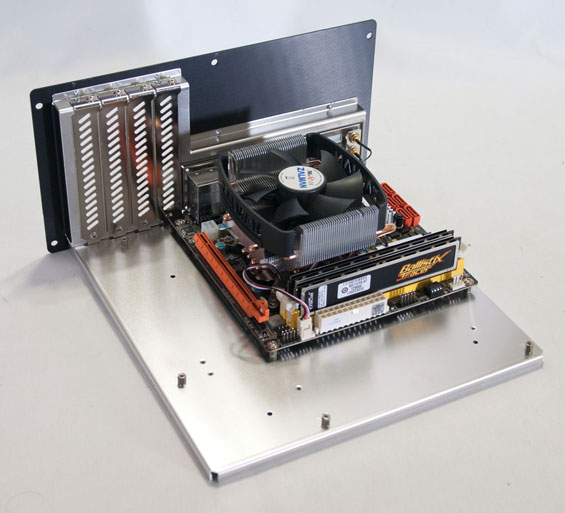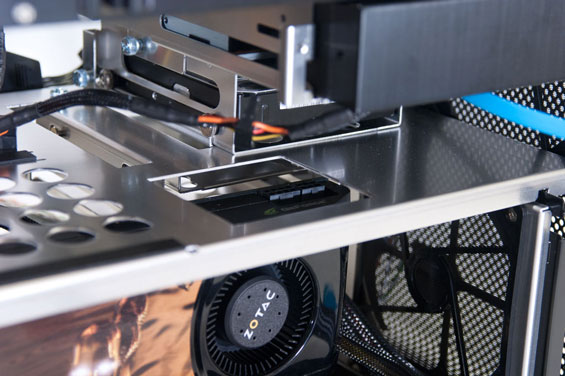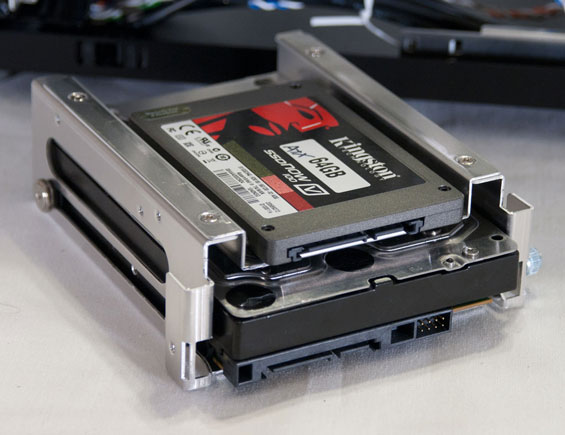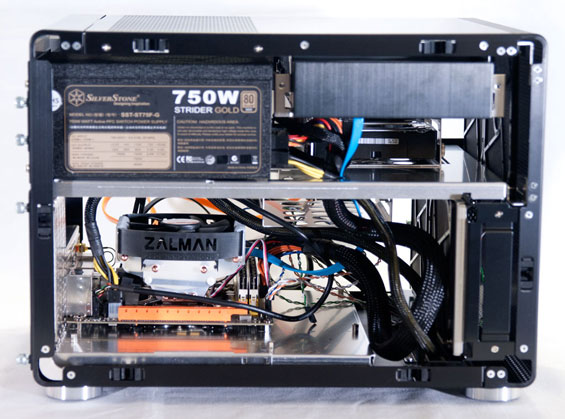Lian Li's PC-V353: Lighter Than Air
by Dustin Sklavos on September 28, 2011 4:30 AM EST- Posted in
- Cases/Cooling/PSUs
- MicroATX
- SFF
- Lian Li
- Mini-Tower
Assembling the Lian Li PC-V353
Lian Li designed the PC-V353's assembly to be tackled essentially in pieces. I have historically endorsed using modular power supplies for any build (to the point where I'm mortified whenever I have to assemble a machine without a modular power supply); in the instance of the PC-V353, I'm about 5% away from making it a requirement.
The PC-V353 breaks down into roughly four parts (five if you're going to argue semantics): the motherboard tray, the drive trays, the power supply mount, and the chassis (which includes the optical drive mount). Because of the nature of the breakdown, it's really in your best interests to wire up each part as best you can before fitting it all together. Since power leads are particularly ornery, that makes a modular power supply that much more vital to assembly in a case like this.

Since the motherboard tray is removable, that part was remarkably easy, though I found the relatively flimsy nature of the tray itself to be a little disconcerting. Everything did come together fine, but it's strange when you're reassuring yourself that it'll work because the rest of the case will have a little give. When I installed the GeForce GTX 580 on the tray, it looked absolutely massive.

Unfortunately, video cards with top-mounted power connectors are liable to be basically hosed when you do install them in the PC-V353, and that's the reason why there are no results for the GTX 580 in the thermal and acoustic testing: the card itself fit fine, but the power connectors were just too thick and there wasn't enough clearance. Lian Li has a cut-out in the top half of the case for routing exactly these power cables, but it didn't line up with our GTX 580, which uses NVIDIA's reference design.

The drives all install in a fairly unique way as well: all of the screws are on rubber-lined runners, and this is true for the 2.5", 3.5" and 5.25" drive mounts. Screws are mounted into the drive first, and then for the 3.5" drive, the drive slides into the rails, and then a thumbscrew locks it into place. Instead of a thumbscrew for the 5.25" drive, it's the fascia. And for the 2.5" drive, there are basically four big holes you drop the screw side into, then push the drive "up" and it locks into place. The system is really quite clever. Again, though, you'll want to wire the drives first. Routing the 5.25" drive's cables requires some doing; you'll want to basically slide them in between the gap between the opposite 5.25" drive bay's fascia and the chassis itself.
Finally, the power supply should go in last and quarters are going to be cramped. If you've been doing this properly and used a modular power supply, your power leads will be connected to the components first so they can be routed up to the power supply at the last stop. If you've been careful, everything should come together reasonably well.

I have to be honest, I'm just not a fan of how the PC-V353 comes together. It feels like it's too unusual, and Lian Li just doesn't make the best use of empty space the way the similar SilverStone does in the Temjin TJ08-E. I have an AVADirect desktop in house that's installed in a Lian Li PC-V354, and honestly that design looks to be a little more sensible than this one. The lack of clearance for the video card's power cables makes all of that case depth feel pointless, and side mounting the optical drive just doesn't seem at all necessary. On top of that, I found the optical drive bay button doesn't line up with our test drive at all. That's not unusual with designs like these, but it makes me wonder why more enclosure designers don't just design a larger button (either externally or internally) that's able to cover the gamut of optical drive eject button placement.
















57 Comments
View All Comments
etamin - Wednesday, September 28, 2011 - link
I think AT case reviews are too concentrated on ease of assembly and performance, not that it's a bad thing but I'd like to see more on practicality. Smaller cases should all scale down to a smaller, quieter PSU. Same with the HSF, a high performance low profile fan like the Scythe Shurikan should be standard to maximize clearance and airflow. I understand the reasoning behind using the same parts for generally all the tests, but I think using more ideal hardware gives a better ceiling of performance one can expect from the case. And one last thing I'm always fretting over: how easy is it to clean the case?? Perforated panels are the worst to clean, and how effective can we expect the filters to be where they are present? I know this is difficult to quantitatively assess, but any insight would be much appreciated.JarredWalton - Wednesday, September 28, 2011 - link
The difficulty with doing "customized builds" is that we'd then have to custom build *every* case to come up with a "best-case scenario" (pun intended). And then what are we reviewing? Most people will use the case as it ships, so disabling fans, or changing orientation of the DVD, or adding fans, etc. is beyond the scope of what they would do. A system builder could do all those things, sure, but they're the ones who would most likely care about ease of assembly.Performance is a tricky thing to analyze; obviously we're only looking at temperatures and noise levels, but with the same core components we can at least say that a particular chassis runs hotter/louder or cooler/quieter than other cases. Any case with no fans can be "silent", but I'd rather have "nearly silent" with a very low RPM fan that can ramp up to audible levels if things are getting too toasty. This case would work fine for someone that wants small and quiet and is willing to give up some performance options. I can't really see that being worth $150+, especially when others are doing it for less.
dacollins - Wednesday, September 28, 2011 - link
I have a previous generation of this case and I absolutely love it. The side access optical drives are weird, but I used the space for hard drives anyways. Working sans CD/DVD was a little difficult at first but I wanted to force myself to make the shift.This is a beautiful case in a form factor that fits perfectly into my entertainment unit in the living room while being just large enough to support a good graphics card. I've been extremely happy with it.
pitashen - Wednesday, September 28, 2011 - link
It is a shame that review like this can get published, but guess this happens a lot in the age of internet.The author failed to familiarize with the Lian-li brand and their entire product lines. Lian-li is known for their using entirely aluminum and being light. Their product are generally on the more expansive side than other brands that use mostly steels.
The author pulled an unfair comparison using Silverstone TJ08-E when they are not in the same form factor category despite both being m-ATX cases. Using Lian-Li PC-A04 would have been an apple to apple comparison to the Silverstone TJ08-E.
JarredWalton - Wednesday, September 28, 2011 - link
The Silverstone is something we have reviewed, and Lian Li didn't send the A04 for review (yet?). The majority of the review isn't focused on the Silverstone but is instead a look at the PC-V353. As always, we compare in graphs to what we've reviewed, but we look at other elements as well.Just because we know who Lian Li is and what they're cases are like doesn't mean they are advertising the aluminum materials, and pretending that we aren't "familiar with the brand" when Dustin states that we've been trying to get their kit in house for a while is typical Internet chest-thumping. Most importantly, you appear to miss the point that this is a review of a specific case. Whether the PC-A04 is a good product is irrelevant to how the PC-V353 stacks up.
The fact is, this particular unit is one of compromise. If you want to use it with a passively cooled CPU and PSU, along with an SSD and no discrete GPU, you can create a silent system. You can do that with just about any case if you want to. Quirky aspects like the interior layout however are just that: quirky. Dustin has handled dozens of case reviews, and knows the market quite well. The bottom line is that this is a small and light case that costs an awful lot of money for what you get, and we feel it's overpriced.
It's a shame that a review like that can get published, because clearly this... what? Is the case expensive or not? Does it require more effort to assemble or not? Does it have limitations in what sorts of hardware it can reasonably support or not? I'm not sure what your real complaint is, other than not being happy that we didn't find a lot to like in the PC-V353. You know what they say about opinions...except we also have some facts to go along with the opinion that this case isn't particularly noteworthy. Higher temperatures, thin materials that can flex, and a difficult assembly are all facts of life with this chassis. You can disagree about whether those things are a deal-breaker if you'd like, but I can't see any of those items being net positives.
As Dustin mentions, we have a couple other Lian Li case reviews coming. Very likely they'll be better than this case, though with the Lian Li brand there's still a good chance they're in the "expensive" category.
xxjudgmentxx - Wednesday, September 28, 2011 - link
This is the 4th iteration of this case design (V350,351,352...) and it's actually pretty awesome. I had a V351 and the side panel and internal design of the 353 SLAAAAAYS it. Yes it's different. If that's really your dealbreaker don't waste people's time reviewing and complaining about non-standard cases.JarredWalton - Wednesday, September 28, 2011 - link
Being different is fine, if the difference is worthwhile. Here, we don't feel there's any advantage to the changes. Changing the internal design to something that requires more assembly time would be fine if there was a clearly superior end result. Allowing the user to switch the sides for the ports and optical drive, however, is a customization that many would be happy to do without. I'll wager that 95% of users go with the stock configuration, with the DVD/ports accessed on the right, because that's how the case ships. So for 5% of users--or even 10%--everyone gets extra cutouts that are covered by a plate, with other compromises as well. It might still be better than the PC-V351, but that doesn't make this perfect.ckryan - Wednesday, September 28, 2011 - link
I might not be in the market for this case, which is like the PC V351 peppered with buckshot, but I am a fan of their 'unique' designs. Unique is great if it works and ridiculous if it doesnt. I went for a Lian Li with no ventilation - one that I could wallpaper with acoustic foam. I traded cooling ability for quietness, but the 353 takes it a bridge too far.I loved the time I spent with the V351 though. It's such an excellent uATX case for the full spectrum. Its main flaw being the inability to use video cards with heat pipes, like MEL's cyclone cards or anything with top mounted PEGs. I loved the side optical bays with that case, cable management was... insufficient ...but it worked. Its nice to see a different take on those elements, but then Lian Li is the prince of weird-ass cases so its actually kinda staid. They either give you a plain aluminum box or a conch shell (no, its a nautilus?)tower...what's not to like?
The first system ever built was with the very first sonata revision. The day I walked into a friends house and saw three Sonatas was the day I decided I was going to use a different kind of case from then on. That's why I'm a fan of the extra-funky Lian Li's.
Dustin, please tell me you have one of those seashell uATX cases on the way...
sweetspot - Wednesday, September 28, 2011 - link
WoW what a rip off, there are full size tower cases with tons more to offer, then this thing at that price point.Lian LI cases are always the worst cases as far as value for price in the market.
A mini case going at a price of a high end full tower model is ridiculous.
tommyj - Wednesday, September 28, 2011 - link
I don't entirely agree with Dustin's methodology (not that I really care about it) or the parts he uses (really using one of those Zalman circle loop coolers?) a lot of the time but I'm actually really glad that for the first time someone said something bad about Lian Li instead of singing praises every time.I've dealt with a lot of aluminum cases from Lian Li when I did work for a computer store and frankly every single one larger than mITX has been a huge disappointment. A lot of the design features in their spacesaver mATX cases range from somewhat understandable to downright stupid - building a few systems in the previous models, I know a few simple changes that could be made to make the case 100% better for quiet computing or high powered systems. Their ATX chassis haven't changed at all since the dawn of time and have long been surpassed by Corsair. The only quality about them is that they make shit about of the lightest materials possible.
Don't get me started on their ultra high end chassis, where their exterior paintjob is pretty much the only thing high quality about them. If you can't build a system well enough in aluminum, stick to steel. Yes its heavier but at least it dampens sound better and isn't flimsy - the Mac Pro chassis is pretty much the gold standard of aluminum cases still and if you can't get side panels as rigid as Apple, don't bother with the material.